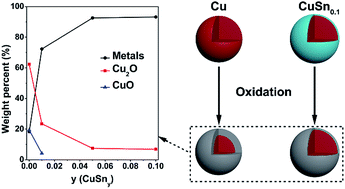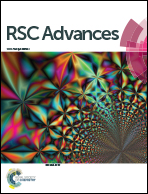Oxidation-resistant micron-sized Cu–Sn solid particles fabricated by a one-step and scalable method†
Abstract
Micron-sized solid Cu–Sn particles have been considered as a replacement for more expensive materials (e.g., Ag, Pd, and Au) in conductive pastes used in printed electronics, solar cell metallization, and interference packaging. With the formation of a tin oxide layer, Cu–Sn particles could combine relatively low electrical resistivity with high oxidation resistance. However the oxidation behavior of this system is not well understood. Here, the oxidation of CuSny solid particles, fabricated by spray pyrolysis without direct addition of H2, was investigated. Our experimental results and theoretical analysis suggest that at a low oxidation temperature (300 °C), the migration of O2− through the oxide layer controls the oxidation. At high temperature (500 °C), the grain growth of the oxide layer is believed to be the rate-limiting step. Among the CuSny particles tested, CuSn0.1 powders exhibited the best particle structure (solid and spherical) and highest oxidation resistance.



 Please wait while we load your content...
Please wait while we load your content...